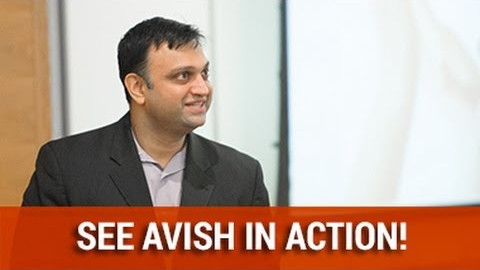Innovation: Your “I Can’ts” Can Become Your Biggest Competitive Advantage
What can’t you do?
As a Motivational Improviser, I like to be positive, and one of my main messages is to focus on the things you can control and do.
Right now, however, I’d like to focus on the other side: all the things you feel you, your team, or your organization just can’t do.
“Why would you do that?” you might be asking. “Isn’t that negative? Won’t that just bring me down?”
It might, if you don’t do it right. However, when you follow a proper process, your “I can’ts” can become your biggest competitive advantage.
My Big “I Can’t”
As a speaker, I use improv comedy ideas to show groups how to think quickly, deal with change, and innovate. In my programs, I play improv games using volunteers as my “game partners.”
Improv is a team activity, and some of the challenging games are very hard to play with volunteers with no improv experience.
When I first started out, there were some great improv performance games that I played very well and that audiences found hilarious, but I felt I couldn’t play them because I didn’t have trained and experienced improviser there to play the games with me.
My thought process was:
I can’t play these games because I don’t have experienced partners to play the games with me.
This was in fact, an entirely legitimate concern.
However, by using my “I can’t” and figuring out a way to do it anyway, I was able to incorporate those games and take my presentations to a whole new level.
It Starts With “What If?”
Using your “I can’ts” to innovate starts with changing your language from “I can’t” to “what if I could?”
This is not about being blindly optimistic or jumping ahead with stupidity. It is simply about focusing your mind and creativity in a new direction.
In my case, I started asking, “what if I could play some of these great improv games in my speeches?” This got my wheels turning about how amazing my program could look.
For You: What are the big “I can’ts” and “we can’ts” facing you and your organization? Change your focus to “what if,” and let your mind play with that for a while.
Then, “If I Could, How Would I?”
Once your mind has gotten comfortable with “what if I could?” the next step is to ask “If I could, how would I?”
This is where you start generating ideas and possibilities for how you can what you currently can’t.
Standard Brainstorming Rules Apply
One reason people fail on this step is because they don’t properly access their creativity. In order to answer the “how would I?” question, you need to let ideas flow from your creativity.
Basic Guidelines:
- Generate Ideas Fast. Whether you are writing them down or saying them out loud, keep the ideas flowing. Evaluate later; now is just the time to generate.
- Express Horrible Ideas. If a terrible idea comes to mind, don’t suppress it, say it or write it down! You need to get those bad ideas out of your head to get to good ones that are hiding behind them.
- Explore Stupid Ideas. Often your best ideas will be variations on stupid ones. Or the stupid idea will inspire the brilliant one.
- Set a Goal that is Far Bigger Than What Seems “Normal.” When brainstorming, you will pretty easily come up with 5 or 10 ideas. The problem is, if they come easily, they probably aren’t all that creative. Set a goal that seems crazy high – 50, or 100, or more. By setting such a high number, you force yourself to tap into your creativity far more than you would otherwise.
(Note: for more in-depth info on how to access and develop your creativity, use the “Sign Up” form on the right column of this page to get a free one-hour MP3 on “How to Think Quick!”)
For You: Set some time aside for your team (or just yourself, if you are a solopreneur) to brainstorm around “how would we?” Lay down brainstorming ground rules first, and make sure everyone understands the idea of saying, “yes, and” instead of “yes, but.”
How it Works
When I did this process for myself, on how I could play some of these more challenging improv games, I came up with a few potential ideas:
- Bring along an experienced improviser to my gigs
- Find and hire a local improviser from the city I would be in
- Work with some volunteers in advance to give them some basic training
- Rework the games so they can work with me playing them solo
- Find ways of making the boring games more fun
- Use video clips of me playing improv instead of ding it live
These are just a sampling of what I came up with. I hated some of these ideas (I had no desire to deal with the logistics of finding improvisers in every city I went to, not to mention the uncertainty of working with someone new each time).
However, 2 of the ideas had promise:
- Work with some volunteers in advance to give them some basic training
- Rework the games so they can work with me playing them solo
For You: Identify the germs of the ideas that could potentially have merit. Even if they don’t seem great now, if you have even an inkling that there’s something there, make a note of it.
It’s An Iterative Process
I liked those ideas, but they were not yet fully formed. They needed some exploring, tweaking, and developing.
This is an important point: don’t expect to find your solution or innovation, immediately on the first pass. At this stage you are just looking for ideas to build upon.
My two ideas both ended up working out, using two different techniques:
- Work With Volunteers in Advance. I really didn’t want to do this. However, there was something there. This was the germ of an idea I could use. What I ended up doing was simply overhauling the “on-stage instructions” I gave my volunteers. While I wasn’t working with them in advance of the speech, I was quickly working with them in advance of the game. This little tweak made a big difference.
- Rework the Games so They Could Work Solo. I liked this idea a lot, but I didn’t see how it could be done. So I went back to the “if I could, how would I question.” From that brainstorming session, I was able to take 3 or 4 games I had never played in a keynote before and use them to great effect.
(Note: to see the results of this work, check out the videos with me in front of the tan background on my videos page)
For You: Dig deeper and explore the ideas you identified in the last step. Brainstorm further until the idea more fully forms. Or, perhaps it won’t fully form, in which case throw it away and move on to the next one.
How About You?
You, your team, and your organization probably have a whole slew of “I can’ts” and “we can’ts.”
Make a list of all the ones you can think of.
Then pay attention and make a note anytime you or someone in your organization mentions an “I can’t.” They may end up being the starting point for your greatest innovations.
Your “I Can’ts” Can Become Your Biggest Competitive Advantage
If you have a big “I can’t,” there’s a good chance that all your competitors have that same “I can’t” too.
- Everyone has to deal with the economy, industry and government
- Everyone has to deal with changes in technology
- All organizations periodically go through changes caused by growth, mergers, or downsizing
Everyone faces obstacles. You can join the masses who lament and complain about these obstacles. OR…
You can get creative and use those “I Can’ts” to innovate, change the game, and leap ahead of your competition.
The choice is up to you…
Innovation Facilitation
 Would this process be useful for you and your team? Then consider hiring Avish to come in and facilitate the process for you! He will lay the ground rules, run through exercises to ensure your team members can access their creativity, and then he will take you through the “I can’t’/Innovation process. Contact him now to get started!
Would this process be useful for you and your team? Then consider hiring Avish to come in and facilitate the process for you! He will lay the ground rules, run through exercises to ensure your team members can access their creativity, and then he will take you through the “I can’t’/Innovation process. Contact him now to get started!













 RSS
RSS Email
Email




